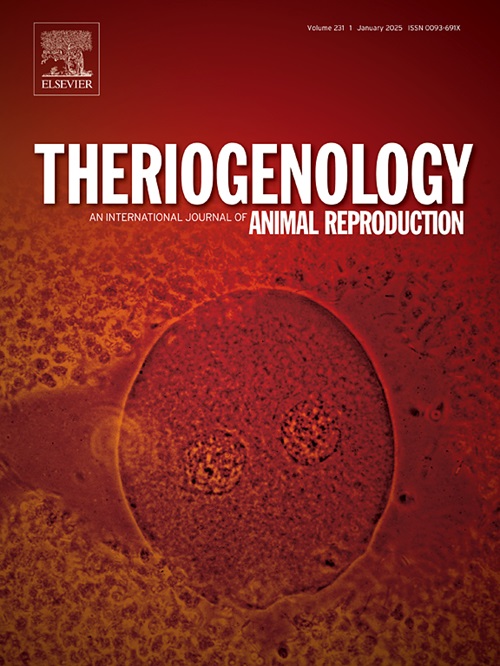Gonadotropin inhibitory hormone (GnIH) induces glucose metabolism disorders and ovarian dysfunction in ovarian white follicles of hens
IF 2.4
2区 农林科学
Q3 REPRODUCTIVE BIOLOGY
引用次数: 0
Abstract
Energy metabolism is crucial for reproduction, and disturbances in glucose metabolism are closely associated with reproductive disorders. The gonadotropin inhibitory hormone (GnIH) plays a crucial role in reproduction and glucose homeostasis in both birds and mammals. However, its specific effects on glucose metabolism-associated ovarian dysfunction in hens remain uncharacterized. In this study, we investigated the effects of GnIH on ovarian function and glucose homeostasis in hens using combined in vivo and in vitro approaches. Our results showed that GnIH and its receptor, GPR147, are predominantly expressed in white follicles. Continuous GnIH injection significantly reduced the ovarian index and the number of prehierarchical follicles, concurrently suppressing Fshr and LHr expression in white follicles. Additionally, metabolomic analyses indicate changes in key glucose metabolism pathways, indicating a regulatory role of GnIH in glucose metabolism. To validate our metabolomics findings, the effects of GnIH on glucose homeostasis in ovarian white follicles and granulosa cells (GCs) were further investigated through in vivo and in vitro studies. The results demonstrated that GnIH enhanced glucose transport, glycolysis and glycogen synthesis, but concurrently induced insulin resistance, oxidative stress, and mitochondrial dysfunction, ultimately leading to reduced energy levels and apoptosis in ovarian tissues. In summary, our study reveals that GnIH contributes to ovarian dysfunction via glucose metabolism dysregulation in hens, suggesting its potential as a therapeutic target for metabolic disorder-associated ovarian impairment in chickens.
促性腺激素抑制激素(GnIH)可引起母鸡卵巢白卵泡糖代谢紊乱和卵巢功能障碍
能量代谢对生殖至关重要,葡萄糖代谢紊乱与生殖障碍密切相关。促性腺激素抑制激素(GnIH)在鸟类和哺乳动物的生殖和葡萄糖稳态中起着至关重要的作用。然而,其对母鸡葡萄糖代谢相关卵巢功能障碍的具体影响尚未明确。在本研究中,我们采用体内和体外联合方法研究了GnIH对母鸡卵巢功能和葡萄糖稳态的影响。结果显示GnIH及其受体GPR147主要在白色卵泡中表达。持续注射GnIH可显著降低卵巢指数和分级前卵泡数量,同时抑制白色卵泡中Fshr和LHr的表达。此外,代谢组学分析表明,关键的葡萄糖代谢途径发生了变化,表明GnIH在葡萄糖代谢中的调节作用。为了验证我们的代谢组学发现,我们通过体内和体外研究进一步研究了GnIH对卵巢白色卵泡和颗粒细胞(GCs)葡萄糖稳态的影响。结果表明,GnIH增强葡萄糖转运、糖酵解和糖原合成,但同时诱导胰岛素抵抗、氧化应激和线粒体功能障碍,最终导致卵巢组织能量水平降低和细胞凋亡。总之,我们的研究表明,GnIH通过母鸡葡萄糖代谢失调导致卵巢功能障碍,这表明它有可能成为母鸡代谢紊乱相关卵巢损伤的治疗靶点。
本文章由计算机程序翻译,如有差异,请以英文原文为准。
求助全文
约1分钟内获得全文
求助全文
来源期刊

Theriogenology
农林科学-生殖生物学
CiteScore
5.50
自引率
14.30%
发文量
387
审稿时长
72 days
期刊介绍:
Theriogenology provides an international forum for researchers, clinicians, and industry professionals in animal reproductive biology. This acclaimed journal publishes articles on a wide range of topics in reproductive and developmental biology, of domestic mammal, avian, and aquatic species as well as wild species which are the object of veterinary care in research or conservation programs.
 求助内容:
求助内容: 应助结果提醒方式:
应助结果提醒方式:


